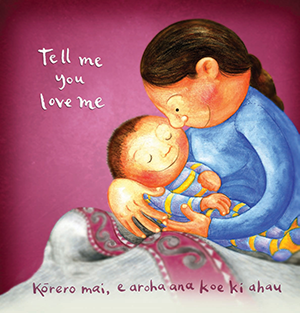
Early days video – when your baby cries
Helping new parents recognise baby’s cues and understand what pēpi is trying to communicate.
Early days - when your baby cries (transcript)
Speaker 1:
When baby was born she was jaundiced so she was a real sleepy baby, and she never really cried until she was about three weeks old I guess. Now when she does cry she either wants a feed, she’s hungry or she needs to be changed or she’s tired. When she’s hungry it’s feed me now, it’s got a bit of passion behind it. When she’s tired it’s a real soft, sad cry I guess; that’s the only way I know how to explain it. Apart from that, she’s pretty content so once you learn what they’re wanting and when they want it then, you’re okay, then everything’s going to be fine.
Speaker 2:
When Dayna was first born and she kept crying, I did not know what to do. I would try nappy changing and then I’d try feeding, and then I’d try burping and then I’d try putting her to sleep, and she would just keep crying and I literally wanted to shake her. With Dayna I learnt that babies cry, and it was just so much easier with Jayden because I knew babies cry, it doesn’t matter. If it’s not one thing, it’ll be the next thing. You try the nappy changing thing then you do the breast feeding, then you do the burping and then you try something else. If they’re tired you take them for a drive in the car or you push them around in the stroller, or you just give them a hug. But, yeah, you learn that babies cry and it’s alright for them to cry. Just try something else. If you’re starting to get frustrated and you know that you’re tired and you’re just at your breaking point, just leave baby, go away for ten minutes, take a few breaths, have a cup of tea, come back and try it all over again and you’ll find that one of those things has worked. If baby does keep crying then maybe it’s time to go to the doctors because it might be an ear ache or something like that.
Carol:
Yeah, we’ve had a few problems with crying, the second time around as well. The first time around obviously, with Emily, you have no idea with the first baby. We did rush to the hospital once when she was ten weeks old because we didn’t know what it was, she was crying constantly which she wasn’t used to doing. With Sophie, it was slightly less tolerant I think of her crying because it should only be for reasons or whatever. But we worked out a system that when it gets too much for me, I pass her over to Mike, even if it’s just to hold until we figure out what it is.
Mike:
Like I take it when Carol’s had enough, just hold her, and Carol will go away and have a little break somewhere and then come back to it.
Carol:
But after a few weeks of spending time with the baby you realise the cries are distinctive. I know her tired cry, I know her feeding cry now and a hungry cry. A lot of it is just spending time with the baby and after a few weeks you do know which cry is which.
Speaker 5:
As we’ve got to know them better, they’re quite different little personalities but there are times when they’re both awake together and they both cry together and you are torn between what you need to do so you need to prioritise a bit and see who really, really needs her feed, that second.
Speaker 6:
There is a difference. I know Emma, she will shout at you a lot and only when she does continually cry you know that she’s ready for some food.
Speaker 5:
She really needs something, whereas Lucy will get going and that’s it, she won’t stop until you tend to her so now Emma has to wait. But they do cry, they cry a lot, and they cry to let you know what they want. They don’t cry because they’re naughty, they cry because they need a nappy change, or they’re starving, or they’re uncomfortable, they’ve got wind. They’re trying to communicate with me. That’s one thing that I found really hard is that they’re trying to tell me something and I can’t deal with it then and there.
Speaker 7:
The hard things in the early days when I first brought her home were the crying, trying to get into a routine, the early morning feeds. Just not knowing what’s wrong with her, whether it’s a nappy or she’s hungry or she’s got wind. I do all three things and then if she was still crying, I just wouldn’t know what was wrong with her, or really it was better for me to just sit with her. When she was crying, I’d just sit there and try to get used to that particular cry. I’d check her nappy and if it was her nappy then that was a cry I got used to. It was just sitting with her and trying to figure out what the sounds of the different cries. For her nappy it’s like a low, grizzly sort of cry and when she’s hungry it’s really high-pitched. Some of the things I do to just relieve my stress from it is either, if I’m on my own I’ll just put her down, block out the cry and turn up the stereo and just de-stress for about 20 or 30 minutes. Or if my mum’s here I’ll just give her to my mum and just go down to my mate’s house for a couple of hours, like an hour or two and just try to not think about it, then I’ll come back and I’ll be all de-stressed and then I can just carry on from there.
Speaker 8:
One of the hardest things with Liam is that he was quite a colicky little baby. He cried a lot and it sounded like he was going to scream the house down. At least I thought he was. He also wasn’t sleeping that well. He would sleep for half an hour or an hour at a time and during the night he was up way more often than I was told babies were supposed to be up, every two hours, every hour and a half. It was quite draining because half the time I was a big trouble-shooter, I didn’t know what to really do for him. I figured if I’d fed him, he was down to sleep and he didn’t have a wet nappy things were okay. But sometimes it wasn’t. We actually tried lots of things with Liam with regards to his colic and I did lots of reading. Once again in theory it’s one thing but in practice it’s a totally different thing. Mostly it was that he just wanted to be held and we did take him to the doctor to suss out a few ways of reducing that pain for him. Eventually, he has grown out of it, he’s a lot better now and really people did say to me he’ll grow out of it and hang in there. I guess that was my light at the end of the tunnel.
Speaker 9:
Just trying anything at the time, you know, whether baby needs rocking, swaying, in the cot, out of the cot, upright, vertical, horizontal, you name it. Whether it’s outside, inside, whether the lights are on or off. Just try everything you can possibly have a crack at and maybe you’ll find something, and you may have a lot of fun too, but you may find that you’ll be really tired, like we did. But I think they’re great stories to tell afterwards too. Maybe at her 21st one day remember all these things.
Even very young babies can communicate what they need and want. It’s up to their parents to learn their special language. This is called ‘reading baby’s cues’.
Learning about baby’s cues
Recognising the cues and understanding what pēpi needs can be a steep learning curve for new parents. If their attempts to soothe baby are unsuccessful, it can add more stress to sometimes tired and anxious parents.
Ask whānau:
- How have you been doing with figuring out what pēpi needs?
- How do you approach it?
Learning from other parents
Hearing from other parents about how they worked out what baby was trying to communicate can be helpful.
Watch ‘The early days’ video clip 'When your baby cries'.(external link)
Familiarise yourself with the video before you watch it with whānau so you can support the discussion well.
Arrange things with whānau ahead of time so that you have the right technology to view the video.
After watching the video together, use some of these questions to prompt discussion with whānau, and to help them understand baby’s crying:
- What did these parents learn about their babies?
- Why do babies cry?
- What are they trying to tell us?
- What can parents do?
- How do we learn to understand them?
- What have you experienced?
- What do your baby’s cries sound like?
- What do their cries mean?
- Do you have any other ideas about baby’s crying?












